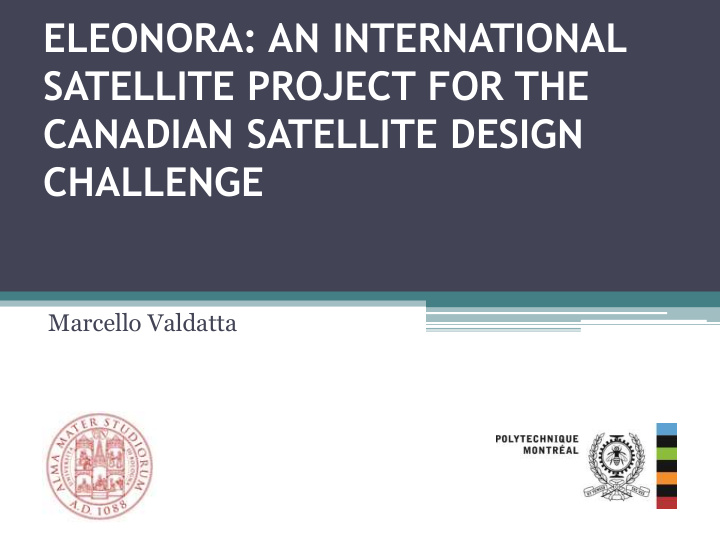



ELEONORA: AN INTERNATIONAL SATELLITE PROJECT FOR THE CANADIAN SATELLITE DESIGN CHALLENGE Marcello Valdatta
Outline • Canadian Satellite Design Challenge • The Team • Scientific Motivation • Project Life Cycle • Conclusions
The Competition • 10 universities involved • Aimed at developing experience in space technologies • 3 design evaluations + environmental testing phase Technical objectives • Total Mass : 4kg • Dimensions: 3U Cubesat • Goal: To have a mission with scientific value • Prize: Orbital launch provided
The Team Polytechnique Montréal • 30 students • 7 engineering disciplines • 3 graduate students + 1 supervising professor University of Bologna • 4 grad students Masters of Aerospace Engineering • 1 Bachelor student
The Technical Society What is it? • Student Association founded to apply a concrete project • Large autonomy including found raising and recruiting (even in other universities) • All activities are managed by the members • Polyorbite in particular was founded for space related activities
The Team
Scientific Motivations Multispectral Imaging of Canadian Arctic Support the research of the Laboratory of Geotechnics and Geomorphology of Cold • Regions • Expertise : Periglacial landforms Mission Objectives: • Provide periodic coverage of Bylot and Baffin islands during arctic summer Measure the effects of global warming • Partner: Prof. Daniel Fortier, UdeM geography department • Courtesy :google Earth
Scientific Motivations • Space Debris Mitigation Graphs: J-C. LIOU, et al. Controlling the growth of future LEO debris population with active debris removal.
Scientific Motivations Without deorbiting system Expected results
Satellite Overview Payload 1 (camera) Subsystems Payload 2 (sail)
Payload (EPM) Technical details: Type CMOS Mass 300 g Resolution Up to 5 Megapixel Power 3.3V • Courtesy GOMSPACE • 1000x1000 km area to scan • On Board processing data to size the photo to 1.6 MB • Machine Learning
Payload (Unibo) Technical details: Size 0.5 CubeSat U Mass 250 g Sail area 50 cm x 50 cm Power (processing 5V output redundancy and acquisition) mechanism • Innovative memory form material • Automatic spring release mechanism (no mechanical spars) • Power input redundancy + two automatic release mechanisms
Project Lifecycle • One and half year duration • Mid term reviews • Environmental and vibration tests • Workshops and lectures • Competition
International Challenges • International collaboration • Voluntary engagement • Communication difficulties • Financial resources • Inexperience
Main Points (Reviews) Reviews and lectures at MDA
Main Points (Integration)
Main Points (Vibrations test) DAVID FLORIDA LABORATORY, CANADIAN SPACE AGENCY
Conclusion • A LOT of lessons learned • Positive scientific results at vibration • Setting new collaborations • Winner of third prize ;)
Thank you for your attention! Marcello.valdatta@gmail.com
Recommend
More recommend